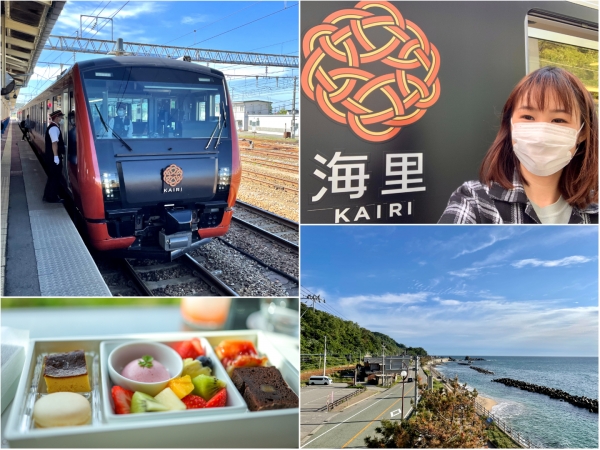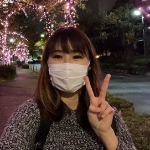Rail Report: Gastronomic delights with a view with the KAIRI

Who doesn't love delicious food and amazing views of Japan? I’m sure plenty of us do! Last June, I, along with my colleagues Carissa, Sue, and Nazrul, had the opportunity to take the pleasure of riding on the KAIRI Joyful Train. With it being the first time boarding the KAIRI and after seeing what my colleagues had experienced during their past trips, needless to say, I was thrilled to board the train. I shall not keep you waiting, so without further ado, let’s begin our trip!
The KAIRI is JR East’s newest dining train, making its debut in October 2019. It runs along the JR Uetsu Main Line (羽越本線 Uetsu-honsen), travelling between Niigata Station (新潟駅 Niigata-eki) in Niigata Prefecture (新潟県 Niigata-ken) to Sakata Station (酒田駅 Sakata-eki) in the Shonai (庄内 Shо̄nai) region of Yamagata Prefecture (山形県 Yamagata-ken). You may wonder, how did the name KAIRI (海里) come about? Well, it actually got its name from the amazing view you can take in while onboard the train: the breath-taking view of the sea (海) and the idyllic countryside villages (里). Another big aspect of this train, of course, is the local gastronomy of Niigata and Shonai.

(Image credit: JR East / Julia Yee)
Starting my journey at Sakata Station, the first thing that drew my eyes’ attention at the platform was the KAIRI’s signature exterior—a gradient of white and deep orange which are meant to represent the fresh snow and sunset. Niigata has some of the highest snowfall in Japan, and is sometimes referred to as Yukiguni (雪国 snow country).
Car 4

(Image credit: Julia Yee)
The train is made up of four cars, and as my seat was located in Car 4, I began exploring the train from its tail-end first. Car 4 is the dedicated dining car which is only available for passengers who have purchased a travel package. I was seated with my colleague Sue in the 2-person seat, but if you’re planning to travel with a slightly bigger group, there are also a few 4-person boxed seats available. Having put down my baggage, I headed to Car 3 which is where the onboard shop and event space is.
Car 3

(Image credit: JR East / Sue Lynn)
In Car 3, there is a sales counter for you to bring home a lovely KAIRI souvenir. There were KAIRI-themed items such as tenugui (手ぬぐい hand towel), keychains, and utensils. There were also little bite-sized snacks available, such as Echigo (越後) bean crackers. Having checked out the counter, I wanted something to commemorate my first trip on this train, so I snagged the cute little KAIRI logo keychain to take home.

(Image credit: JR East / Julia Yee)
There is also an event space inside the car where performances are conducted on special occasions. Unfortunately, there wasn’t one during my trip, but I noticed that there is where I could get my commemorative stamp. A popular collectible among train fans, this stamp had the motif of KAIRI and with its new upgraded system, it was really easy to get the perfect stamp. There are pieces of paper available for you to stamp on, and once that was done, I held onto it carefully as I headed to the next car.
Car 2 and 1

(Image credit: JR East / Julia Yee)
Car 2 is another passenger car, but here it features cosy compartment seats instead. Such seats are great for small groups of people who value some privacy during their time on the train, as well as families who would like to be seated together. The seats are only on one side of the car, and it’s for a simple reason: they are located on the side that directly faces the Sea of Japan. This way, all passengers can get to enjoy a full view of the glistening sea as the train makes its way along the coastline. How cool is that?!

(Image credit: JR East / Julia Yee)
Car 1 is the passenger car with a regular two-by-two seat configuration. I was amazed that all the seats are reclinable and have generous legroom. Even if you’re in Car 1, the car features large windows so that passengers can enjoy a full unobstructed view of the outdoor scenery.
Tsuruoka Station bound

(Image credit: JR East / Julia Yee)
Having completed my exploration of the train, I promptly returned to my seat in Car 4. As we departed Sakata Station, I selected my Welcome Drink from the menu on the table. All the drinks sounded delicious, featuring both alcoholic and non-alcoholic options of locally produced beverages. I settled with the Sparkling Wine which was the chef’s recommendation.

(Image credit: JR East / Sue Lynn & Julia Yee )
After about 30 minutes, the train arrived at Tsuruoka Station (鶴岡駅 Tsuruoka-eki). The train stopped here for 20–30 minutes, and this gave me some time to explore the station. The station offered a couple of souvenir shops and a waiting area for customers—perfect if you would like to grab an omiyage (お土産) to bring home. There was also a little booth to get your station stamp—similar to the one I got on the KAIRI—and a replica of the famous Hachiko Statue found in Shibuya, Tokyo.
Time to dig in!

What’s in the box? (Image credit: JR East / Julia Yee)
Hurrying back to my seat, it was soon time to dig into the delicious meal served on the KAIRI. The meal I was served during our trip was from Al Ché-cciano (アル・ケッチァーノ), a local restaurant which offers Italian cuisine made using produce native to Yamagata Prefecture, unique to the Shonai area. The lovely train staff was truly amazing, and as she served the meals, she introduced and provided explanations on each of the dishes.

The Al Ché-cciano Box (top) and the Farinamore Dolce Box (bottom). (Image credit: JR East / Sue Lynn)
I was amazed by the exquisite box which was presented to me, and it felt as though I was opening a present! The first box was the Al Ché-cciano Box which featured mouthwatering, savoury food items, while the second box, the Farinamore Dolce Box (ファリナモーレ・ドルチェの箱 Farinamōre doruche no hako), featured dessert items such as cakes and sweets complemented by fruits.

Dining with a view! (Image credit: JR East / Julia Yee)
As I am more of a savoury-food kind of person, my favourite item was definitely the Yamagata Beef and Yamagata Celery braised with tomato, delicious! While savouring my lavish meals, I got to enjoy the stunning views of the Sea of Japan and Niigata’s rural countryside passing by.
Kuwagawa Station

(Image credit: JR East / Julia Yee)
The most scenic portion during my trip was when the train passed by the Sasagawa Nagare (笹川流れ), an 11km stretch of coastline with beautiful sapphire blue waters and unique rock formations eroded by seawater. Along this stretch, an announcement is made and the train will slow down for you to take photos. The train even makes a stop at JR Kuwagawa Station (桑川駅 Kuwagawa-eki) for 20–30 minutes, where you can get off to get a closer look at the sea and enjoy a special dessert—the Sea of Japan soft-serve ice cream (日本海ソフトクリーム Nihonkai sofuto kurīmu).

I wanted to get a good snapshot of the ice cream by the beautiful sea but my ice cream began melting, no~! (Image credit: JR East / Julia Yee)
This specially-crafted ice cream is only served at the Kuwagawa Michi-no-eki (桑川道の駅) next to the station. The vibrant blue is meant to represent the blue of the sea, while the grape salt sprinkled on the ice cream gives a unique flavour and depth. The salted caramel peanut cookie also adds crunch and texture to this sweet treat.
Niigata Station & Kiwamizushi
The 4-hour journey onboard the train ended all too quickly for me… (Image credit: JR East / Julia Yee)
Having gotten my fill of the gentle sea breeze and yummy treat, I returned to the train for the last leg of my journey. At 6:30pm, I finally arrived at the last stop, Niigata Station, and it was time to bid farewell to the KAIRI. Having had a great time onboard the train, I grabbed my luggage and alighted the train. Despite having all the delectable food onboard the train, it was now time for dinner. Having had our fill of Italian cuisine, we were craving sushi, and our go-to spot was just a stone’s throw away from the station: Tomizushi (富寿し).

More food! (Image credit: JR East / Julia Yee)
Niigata Prefecture is famous for a variety of things, one of which is kiwamizushi (極み寿司). Knowing that we simply had to get it, we promptly placed our order on the iPad. Kiwamizushi is a special platter which features 10 pieces of the finest seafood offered by participating establishments in the prefecture. The platter includes local seasonal offerings unavailable anywhere else, together with uni (ウニ sea urchin roe), toro (トロ medium-fat tuna), and ikura (いくら salmon roe). The content varies according to the season and sea conditions, but you can always be sure you will be eating the best fish of the day. Needless to say, the sushi was so phenomenal that we devoured our platter in under 20 minutes, and the arajiru (あら汁 sea bream soup) was very tasty and flavourful—the perfect way to end off a long day.
Closing

I took more photos of the scenery and food, and realised I don’t have many photos with me in it. So here they are! (Image credit: JR East / Jullia Yee)
Overall, having the opportunity to ride on the KAIRI was one of the most memorable railway trips I had. It may be hard to believe, but everything was amazing and I can’t reiterate enough how every meal was enjoyable, and it was an eye-opening experience to explore the different parts of Eastern Japan. If this sounds like your cup of tea, I highly recommend you ride the KAIRI during your next trip to Japan. If you would like to know the Japanese cuisine which is also served on the KAIRI from Niigata Station to Tsuruoka Station, you can check out my colleague Carissa’s article here.
KAIRI (海里)
Route: Niigata Station (新潟駅) ↔️ Sakata Station (酒田駅) on the JR Uetsu Main Line
Price: ¥15,000/adult for Japanese course, ¥11,500/adult for Italian course
Booking limit: Minimum one pax / maximum four pax per booking
Booking deadline: 4 days before departure
Note: The KAIRI Car 4 is a package-only car. You will not be able to board this car with just a rail pass. However, rail pass holders who wish to board the train without meals can reserve seats for Car 1 or Car 2. This train is all reserved seating only, so advanced seat reservations are required.
Header image credit: JR East / Sue Lynn & Julia Yee




